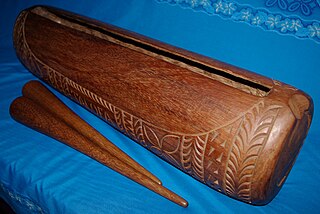
Tokelau is a dependent territory of New Zealand in the southern Pacific Ocean. It consists of three tropical coral atolls: Atafu, Nukunonu, and Fakaofo. They have a combined land area of 10 km2 (4 sq mi). In addition to these three, Swains Island, which forms part of the same archipelago, is the subject of an ongoing territorial dispute; it is currently administered by the United States as part of American Samoa. Tokelau lies north of the Samoan Islands, east of Tuvalu, south of the Phoenix Islands, southwest of the more distant Line Islands, and northwest of the Cook Islands.

Music of Tonga refers to music derived from the island Tonga in the islands of Polynesia. Music of Tonga today generally falls under the category of traditional music that has withstood the test of time, or into one of the two opposing genres of religious and secular music. Tongan music can be either very emotional and somewhat modern with instrumental makeup including modern brass instruments, or conversely can be more traditional and consist of only drums and voices. In this way, Tongan music is very diverse despite the fact that it is contained to a fairly small island, which means that the different cultures and styles co-exist on the small land mass together without blending.

The traditional music of Tuvalu consists of dances, including fatele, fakanau and fakaseasea. The influence of the Samoan missionaries sent to Tuvalu by the London Missionary Society from the 1860s resulted in the suppression of songs about the traditional religions or magic and many songs were lost. As the influence of the missionaries diminished in the 20th century the traditional dances were revived and the siva dance tradition from Samoa also became popular.
Tokelauan is a Polynesian language spoken in Tokelau and historically by the small population of Swains Island in American Samoa. It is closely related to Tuvaluan and is related to Samoan and other Polynesian languages. Tokelauan has a co-official status with English in Tokelau. There are approximately 4,260 speakers of Tokelauan, of whom 2,100 live in New Zealand, 1,400 in Tokelau, and 17 in Swains Island. "Tokelau" means "north-northeast".

The politics of Tokelau takes place within a framework of a parliamentary representative democratic dependency. The head of state of Tokelau is King Charles III in right of his Realm of New Zealand, who is represented by an Administrator. The monarch is hereditary, the Administrator is appointed by the New Zealand Minister of Foreign Affairs and Trade.
Te Vaka is an Oceanic music group that performs original contemporary Pacific music or "South Pacific Fusion". The group was founded in 1995 by singer and songwriter Opetaia Foaʻi in New Zealand. They have toured the world consistently since 1997 and have won a number of awards including the "Best Pacific Music Album" award from the New Zealand Music Awards for their albums Tutuki (2004) and Olatia (2007) and "Best Pacific Group" in the 2008 Pacific Music Awards According to the BBC, they are "the world's most successful band playing original contemporary Pacific music."

The Pātē is a Samoan percussion instrument of Tahitian origin, named after the Samoan word for "beat" or "clap" "pulse". It is one of many Samoan log drum variants and is of the slit drum family, and therefore is also of the idiophone percussion family. It is made from a hollowed-out log, usually of Miro wood and produces a distinctive and loud sound. Different sizes of log drums offer different pitches and volumes, as well as striking the log drum in the middle or near the ends.

Severe Tropical Cyclone Percy was an extremely powerful tropical cyclone which was the third and last Category 5 cyclone to form in the 2004–05 South Pacific cyclone season. The seventh named storm and the fourth and final severe tropical cyclone to form during the 2004–05 South Pacific cyclone season. Percy originated as a tropical disturbance on February 23. Over the course of the next few days, the system organized while moving east-southeastward, before intensifying into a Category 1 tropical cyclone on the Australian region scale on February 26. The system quickly intensified, reaching Category 4 status later that day. On the next day, Percy was steered southward by a blocking ridge of high pressure, while stretched out the structure of the storm into an elliptical shape, weakening it back to Category 3 status. Afterward, the storm rapidly reintensified, reaching its peak intensity as a Category 5 tropical cyclone on March 2. Afterward, Percy encountered increasing wind shear and weakened once again, turning southeastward on the next day. On March 5, Percy transitioned into an extratropical storm, before dissipating soon afterward.

The Roman Catholic Mission Sui Iuris of Tokelau in Tokelau is a suffragan mission of the Roman Catholic Archdiocese of Samoa-Apia. It was formed in 1992 when the Archdiocese of Samoa-Apia and Tokelau was split into the Archdiocese of Samoa-Apia and the Mission Sui Iuris of Tokelau. The position of Ecclesiastical Superior is currently vacant following the death of Archbishop Alapati Lui Mata’eliga on 25 April 2023.

The following outline is provided as an overview of and topical guide to Tokelau:

Tokelau has two official languages: Tokelauan and English. Over 90% of the population speaks Tokelauan, and just under 60% speak English. Also, 45.8% of the population speak Samoan, and small percentages of the population speak Tuvaluan and Kiribati.
The following is an alphabetical list of articles related to Tokelau.
The Treaty of Tokehega, officially titled the Treaty between the United States of America and New Zealand on the Delimitation of the Maritime Boundary between Tokelau and the United States of America, is a 1980 treaty between New Zealand and the United States that settles disputed claims and delineates the maritime boundary between Tokelau and American Samoa. The treaty's short name is a portmanteau of Tokelau and Olohega, which the boundary separates.

In Uvea (Wallis) and Futuna, dances play a major cultural role. One sees dance in fakahaha'aga (festivals), to'oto'oga, or just for pure pleasure. In Uvea, the term faiva is used for dance, whereas the term mako is used. In Uvea and Futuna there is a katoaga which is only celebrated with the visit of chiefs and if lucky, with the Lavelua (King). As the years go by, dance and culture is still alive and well in Uvea and Futuna. The normal fakapale is given to the dancers for their magnificent dance. The following dances of Uvea and Futuna below are just some of the dances, or are the main dances seen in Wallisian and Futunan culture.
A fakanau is a traditional Tuvaluan male dance, accompanied by singing and rhythmic clapping.

The fatele or faatele is a traditional dance song of Tuvalu. Dancing songs are the most common type of traditional Tuvaluan song, with other traditional dance styles including fakanau and fakaseasea.

The vast majority of people in Tokelau are Christians and Christianity plays a significant role in the Tokelauan way of life.
Smoking in Tokelau is prevalent, with ethnic Tokelauans having the highest smoking prevalence of all Pacific ethnicities. In the 2011 Tokelau Census, 47.8% of people aged over 15 were found to be regular cigarette smokers.

The Western Polynesian tropical moist forests is a tropical and subtropical moist broadleaf forests ecoregion in Polynesia. It includes Tuvalu, the Phoenix Islands in Kiribati, Tokelau, and Howland and Baker islands, which are possessions of the United States.










